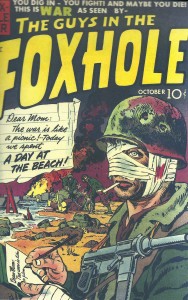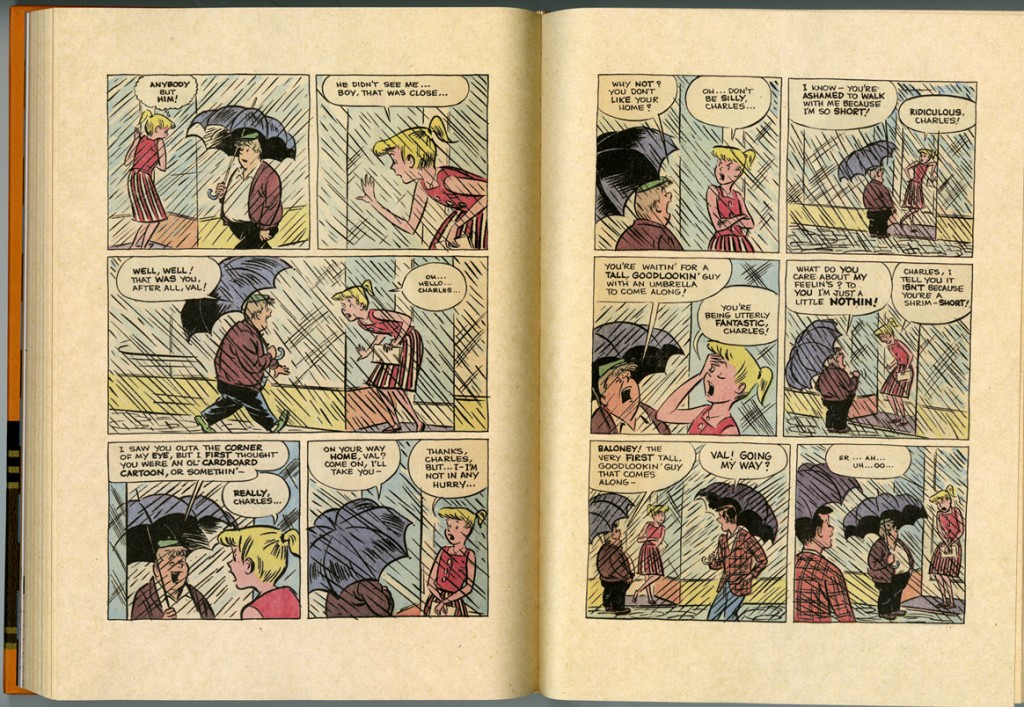 Preface: I wrote this in my notebook after discovering last week that the conclusion to the major re-launch of the 1980s series Nexus had hit the stands. Steve Rude, one of the biggest “indie” comics creators of the last 25 years, made a comeback — to the sound of crickets. No one cared. To me, that meant the Direct Market was really finally and absolutely dead. Everyone said it was dead last summer when Love and Rockets abandoned its pamphlet comic book format and went to an annual trade paperback format. Like Love and Rockets, the fate of Nexus was bound up in the history of the Direct Market. But unlike Love and Rockets, Nexus was suited for the “alternative mainstream” fan. It was a particular kind of adult superhero book that appealed to a seemingly more sophisticated audience than the regular superhero comics. The DM supported titles like Nexus and allowed them to thrive. Not any more. Maybe everyone’s just had their fill of Nexus but the news of this indie’s end got me thinking about the bigger picture. The end of Nexus represents, to me, a window of time that has closed. The new regime is upon us at last, and I wrote this to simply mark the time. Also, the below is really an exploration, for me, into ideas that my friend and mentor Bill Boichel of Copacetic Comics has expressed to me for years—in his store, over the phone, in emails, in class lectures. The “bridge” and “tree” metaphors are pure Boichel. Thanks Bill, for letting borrow your melody line and riff on it here.
Preface: I wrote this in my notebook after discovering last week that the conclusion to the major re-launch of the 1980s series Nexus had hit the stands. Steve Rude, one of the biggest “indie” comics creators of the last 25 years, made a comeback — to the sound of crickets. No one cared. To me, that meant the Direct Market was really finally and absolutely dead. Everyone said it was dead last summer when Love and Rockets abandoned its pamphlet comic book format and went to an annual trade paperback format. Like Love and Rockets, the fate of Nexus was bound up in the history of the Direct Market. But unlike Love and Rockets, Nexus was suited for the “alternative mainstream” fan. It was a particular kind of adult superhero book that appealed to a seemingly more sophisticated audience than the regular superhero comics. The DM supported titles like Nexus and allowed them to thrive. Not any more. Maybe everyone’s just had their fill of Nexus but the news of this indie’s end got me thinking about the bigger picture. The end of Nexus represents, to me, a window of time that has closed. The new regime is upon us at last, and I wrote this to simply mark the time. Also, the below is really an exploration, for me, into ideas that my friend and mentor Bill Boichel of Copacetic Comics has expressed to me for years—in his store, over the phone, in emails, in class lectures. The “bridge” and “tree” metaphors are pure Boichel. Thanks Bill, for letting borrow your melody line and riff on it here.
——————————————————–
The bridge is over. From 1975 to 2005, the Direct Market was the bridge from the old world “Comics-as-ephemera”, returnable periodicals model to the new world “Comics-as-Literature” bookstore model. The bridge changed comics, saved it from sure death on the newsstand and put comics in a place of permanence. Everyone in Comics has noted the consolidation of the DM and the rise of the chain bookstores & the internet as venues for new work. Now, this year, more than ever, I seem to be repeatedly noting to myself the real split between the mainstream and the alternative sides of comics.
During the heyday of the Direct Market in the late ’80s and early ’90s mainstream and alternative comics were together in one marketplace because there was no other option essentially, no bookstore support, no internet. What that meant was the two traditions were folded together. Gilbert Hernandez and Steve Ditko were on the same rack literally and figuratively. The old mainstream guys influenced the young alt guys, there was a clear traceable legacy. One could see Bernie Krigstein’s influence on Dan Clowes, Jack Kirby’s influence on Chester Brown, Ditko’s influence on Hernandez. It was a singular perspective essentially. One big sandbox. One tradition.
The market can now support multiple perspectives. It is not a monolithic community. There is no official definition of Comics now. It’s too big. Finally “comics” doesn’t just mean American mainstream super-hero action adventure stories. (Well, comics never meant just that genre, but y’know what I’m saying: Marvel and DC have lorded over the form for almost 50 years.) In 2009 you can walk into a comics store like Copacetic Comics in Pittsburgh and see no superhero comics on display at all. There are enough “alternative” or “literary” comics/graphic novels out in the world to fill a whole (small) store. And there are “alternative” publishers who don’t use (or are shut out from) the Direct Market and who use book trade distributors to get the work out to stores.
So we got what you might call a bifurcated market. The two traditions, once folded together in the same market, have split. There are two sandboxes now. What that means is that if you grew up reading comics from, say, 1999 to now you didn’t necessarily have to read superhero comics to get your comics fix or even go to a store that sold both. This is a good thing. It’s a new audience, and a broader one than maybe any of us old school dinosaurs could have anticipated. I’ve spent far too much time ranting about “the kids not knowing their comics history.” Well, I’m over it. I don’t really feel the need to explain who Marshall Rogers is anymore, or convince anyone that late ’70s Kirby is actually really good. Figure it out for yourself.
This new audience, I think, is alienated by superhero comics and associates the genre with corporate America. They don’t like it. And who can blame them? They wonder why folks like me keep extolling the abilities of some guy who drew Spider-Man. They could care less. I had a student tell me, “Yah, it’s beautiful art but it’s Spider-Man.” This too, this palpable attitude, is a good thing. After all, aren’t Batman and Spider-Man just corporate logos these days?
 Comics history is like one big tree where McCay and Herriman are the roots, Kirby and Caniff are the trunk, Crumb and Spiegelman are big branches, and the rest of us schlubs are up there somewhere. It’s all connected. Each generation has its precursors. I would assert, however, that for the first time in comics history it’s possible to graft new identities upon the tree without being schooled in the singular tradition, without growing out of the singular tradition. One can choose precursors from other traditions, not just from comics.
Comics history is like one big tree where McCay and Herriman are the roots, Kirby and Caniff are the trunk, Crumb and Spiegelman are big branches, and the rest of us schlubs are up there somewhere. It’s all connected. Each generation has its precursors. I would assert, however, that for the first time in comics history it’s possible to graft new identities upon the tree without being schooled in the singular tradition, without growing out of the singular tradition. One can choose precursors from other traditions, not just from comics.
I see Persepolis as an example of this grafting. It is at once outside the tradition of comics and within the boundaries of the form. I feel that it was only possible to come into existence because of the split that happened some time in the last 10 years. I’m sure that’s no big revelation for most of you, but it’s something to consider as we move forward into the next decade. It’s now possible to bypass a very particular, esoteric education in “mainstream” comics, and go right to its “alternative” and also to the avant-garde. It opens the door for “vertical invaders,” for artists from different traditions to make work and to find an audience. The marketplace will support a book like Persepolis, I think, precisely because it is divorced from the old world model. Satrapi’s free from the “Tree of Influence” that’s existed in comics; she’s free to draw in a straight-forward generic style that is appealing to a vast audience. (Think of it this way: As “straight-forward” or “realistic” Clowes’ style in Ghost World is to a schooled comics reader, it looks baroque and affected to a non-comics reader.)
One could say comics like L’nR and Optic Nerve may have been the first to appeal to this emerging audience. But I feel that those books didn’t/don’t cross over so much as Acme Novelty Library or Persepolis because the styles of the Hernandez Brothers and also of Tomine are essentially derived from the mainstream comics and illustration tradition. I feel that it was Ware’s choice to reach beyond the mainstream tradition back to the newspaper strip golden age that has allowed him to have such a diverse audience. It seems this new emerging audience still connects particular styles back to mainstream comics. I’m curious to see how Mazzucchelli’s new book does now that he has “unlearned” all his mainstream tricks. ( I also think Seth’s eventual collection of Clyde Fans will “cross over” to an audience beyond comics. He has a style that has little to do with mainstream comics. Interestingly enough, Seth said recently: “I am converting Palookaville into a hardcover format this year. I love the old comic format but Chris Oliveros convinced me that the work would do better if we moved on to this new direction. It’s kind of sad, passing of an era and all that.”)
So, here we are: Summer 2009. Whatever system we have now, it’s working. Pamphlets still get published even if they only serve as advertisements for the collection, GN’s sell better and better, downloads are happening, comics are on Kindle: whatever works. However, in the process it feels like a real division has been formed between the “mainstream” and the “alternative” factions. A division that was always there underneath, forming. But now it’s ruptured and split the marketplace.
Which brings me to Comic-Con. San Diego Comic-Con will always be some sort of Oscars for our community. But whose community is it anymore? Increasingly it’s the motion picture industry’s community. It’s not about “the work” anymore. It’s definitely not about the creators or even the comic book dealers. It may be cool for most mainstream creators or fans but what’s in it for us in the “alternative” community? Not much. So I gotta wonder why “we” still go. I can certainly understand why Fantagraphics and D&Q go (it’s the biggest show of the year, duh) and that Comic-Con is still profitable for them. But for me and my comrades over here on the fringe of the fringe we feel like we’re getting priced out of our own neighborhood. The split seems this year to be more pronounced than ever and it looks like those in the “mainstream” have no choice really but to hold on for dear life as they become co-opted even further into corporate America. They really have no choice. They sold themselves out years ago.
But the alternative comics community does have a choice. So give me TCAF, SPX, MoCCA, SPACE, Stumptown, and the “alternative” circuit and tell Comic-Con and the Direct Market, “Thanks for the memories.” The bridge is over.



























